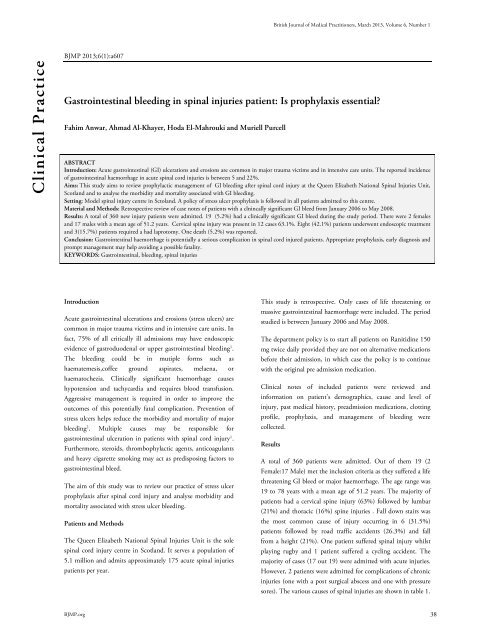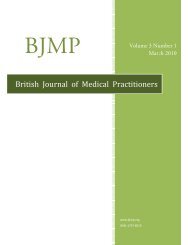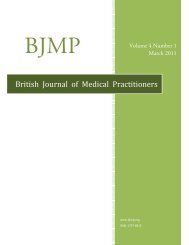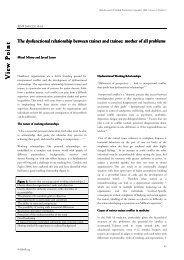R esearch A rticle - British Journal of Medical Practitioners
R esearch A rticle - British Journal of Medical Practitioners
R esearch A rticle - British Journal of Medical Practitioners
Create successful ePaper yourself
Turn your PDF publications into a flip-book with our unique Google optimized e-Paper software.
<strong>British</strong> <strong>Journal</strong> <strong>of</strong> <strong>Medical</strong> <strong>Practitioners</strong>, March 2013, Volume 6, Number 1<br />
BJMP 2013;6(1):a607<br />
Clinical Practice<br />
Gastrointestinal bleeding in spinal injuries patient: Is prophylaxis essential<br />
Fahim Anwar, Ahmad Al-Khayer, Hoda El-Mahrouki and Muriell Purcell<br />
ABSTRACT<br />
Introduction: Acute gastrointestinal (GI) ulcerations and erosions are common in major trauma victims and in intensive care units. The reported incidence<br />
<strong>of</strong> gastrointestinal haemorrhage in acute spinal cord injuries is between 5 and 22%.<br />
Aims: This study aims to review prophylactic management <strong>of</strong> GI bleeding after spinal cord injury at the Queen Elizabeth National Spinal Injuries Unit,<br />
Scotland and to analyse the morbidity and mortality associated with GI bleeding.<br />
Setting: Model spinal injury centre in Sctoland. A policy <strong>of</strong> stress ulcer prophylaxis is followed in all patients admitted to this centre.<br />
Material and Methods: Retrospective review <strong>of</strong> case notes <strong>of</strong> patients with a clnincally significant GI bleed from January 2006 to May 2008.<br />
Results: A total <strong>of</strong> 360 new injury patients were admitted. 19 (5.2%) had a clinically significant GI bleed during the study period. There were 2 females<br />
and 17 males with a mean age <strong>of</strong> 51.2 years. Cervical spine injury was present in 12 cases 63.1%. Eight (42.1%) patients underwent endoscopic treatment<br />
and 3(15.7%) patients required a had laprotomy. One death (5.2%) was reported.<br />
Conclusion: Gastrointestinal haemorrhage is potentially a serious complication in spinal cord injured patients. Appropriate prophylaxis, early diagnosis and<br />
prompt management may help avoiding a possible fatality.<br />
KEYWORDS: Gastrointestinal, bleeding, spinal injuries<br />
Introduction<br />
Acute gastrointestinal ulcerations and erosions (stress ulcers) are<br />
common in major trauma victims and in intensive care units. In<br />
fact, 75% <strong>of</strong> all critically ill admissions may have endoscopic<br />
evidence <strong>of</strong> gastroduodenal or upper gastrointestinal bleeding 1 .<br />
The bleeding could be in mutiple forms such as<br />
haematemesis,c<strong>of</strong>fee ground aspirates, melaena, or<br />
haematochezia. Clinically significant haemorrhage causes<br />
hypotension and tachycardia and requires blood transfusion.<br />
Aggressive management is required in order to improve the<br />
outcomes <strong>of</strong> this potentially fatal complication. Prevention <strong>of</strong><br />
stress ulcers helps reduce the morbidity and mortality <strong>of</strong> major<br />
bleeding 2 . Multiple causes may be responsible for<br />
gastrointestinal ulceration in patients with spinal cord injury 1 .<br />
Furthermore, steroids, thrombophylactic agents, anticoagulants<br />
and heavy cigarette smoking may act as predisposing factors to<br />
gastrointestinal bleed.<br />
The aim <strong>of</strong> this study was to review our practice <strong>of</strong> stress ulcer<br />
prophylaxis after spinal cord injury and analyse morbidity and<br />
mortality associated with stress ulcer bleeding.<br />
Patients and Methods<br />
The Queen Elizabeth National Spinal Injuries Unit is the sole<br />
spinal cord injury centre in Scotland. It serves a population <strong>of</strong><br />
5.1 million and admits approximately 175 acute spinal injuries<br />
patients per year.<br />
This study is retrospective. Only cases <strong>of</strong> life threatening or<br />
massive gastrointestinal haemorrhage were included. The period<br />
studied is between January 2006 and May 2008.<br />
The department policy is to start all patients on Ranitidine 150<br />
mg twice daily provided they are not on alternative medications<br />
before their admission, in which case the policy is to continue<br />
with the original pre admission medication.<br />
Clinical notes <strong>of</strong> included patients were reviewed and<br />
information on patient’s demographics, cause and level <strong>of</strong><br />
injury, past medical history, preadmission medications, clotting<br />
pr<strong>of</strong>ile, prophylaxis, and management <strong>of</strong> bleeding were<br />
collected.<br />
Results<br />
A total <strong>of</strong> 360 patients were admitted. Out <strong>of</strong> them 19 (2<br />
Female:17 Male) met the inclusion criteria as they suffered a life<br />
threatening GI bleed or major haemorrhage. The age range was<br />
19 to 78 years with a mean age <strong>of</strong> 51.2 years. The majority <strong>of</strong><br />
patients had a cervical spine injury (63%) followed by lumbar<br />
(21%) and thoracic (16%) spine injuries . Fall down stairs was<br />
the most common cause <strong>of</strong> injury occurring in 6 (31.5%)<br />
patients followed by road traffic accidents (26.3%) and fall<br />
from a height (21%). One patient suffered spinal injury whilst<br />
playing rugby and 1 patient suffered a cycling accident. The<br />
majority <strong>of</strong> cases (17 out 19) were admitted with acute injuries.<br />
However, 2 patients were admitted for complications <strong>of</strong> chronic<br />
injuries (one with a post surgical abscess and one with pressure<br />
sores). The various causes <strong>of</strong> spinal injuries are shown in table 1.<br />
BJMP.org<br />
38







